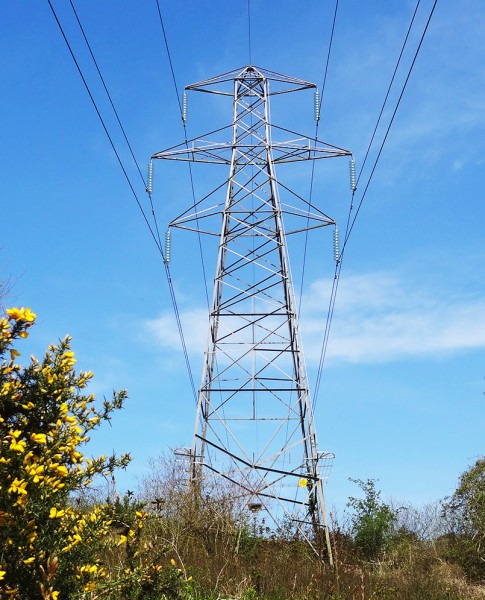 The cost of living is a contentious issue and is likely to form a key part of the political debate for the next few years. This debate has been fuelled by the latest announcement by SSE of an average rise in consumer energy bills of 8.2%, meaning that an average dual-fuel customer would see its bill rise by £106. With this increase, the expectation is that the other big energy companies will follow suit with their own price rises.
The cost of living is a contentious issue and is likely to form a key part of the political debate for the next few years. This debate has been fuelled by the latest announcement by SSE of an average rise in consumer energy bills of 8.2%, meaning that an average dual-fuel customer would see its bill rise by £106. With this increase, the expectation is that the other big energy companies will follow suit with their own price rises.
Energy prices are made up of numerous factors, including wholesale prices, investment in infrastructure and innovation, together with government green energy taxes. SSE has put their price hike down to an increase in wholesale prices, but has also passed part of the blame onto the government by suggesting that the price hikes are required to offset the government’s energy taxes. Will Morris, from SSE said:
We’re sorry we have to do this…We’ve done as much as we could to keep prices down, but the reality is that buying wholesale energy in global markets, delivering it to customers’ homes, and government-imposed levies collected through bills – endorsed by all the major parties – all cost more than they did last year.
The price hike has been met with outrage from customers and the government and has provided Ed Miliband with further ammunition against the Coalition’s policies. However, even this announcement has yet to provide the support for Labour’s plans to freeze energy prices, as discussed in the blog Miliband’s freeze.  Customers with other energy companies are likely to see similar price rises in the coming months, as SSE’s announcement is only the first of many. A key question is how will the country provide the funding for much needed investment in the energy sector? The funds of the government are certainly not going to be available to provide investment, so the job must pass to the energy companies and in turn the consumers. It is this that is given as a key reason for the price rises.
Customers with other energy companies are likely to see similar price rises in the coming months, as SSE’s announcement is only the first of many. A key question is how will the country provide the funding for much needed investment in the energy sector? The funds of the government are certainly not going to be available to provide investment, so the job must pass to the energy companies and in turn the consumers. It is this that is given as a key reason for the price rises.
Investment in the energy infrastructure is essential for the British economy, especially given the lack of investment that we have seen over successive governments – both Labour and Conservative. Furthermore, the government’s green targets are essential and taxation is a key mechanism to meet them. Labour has been criticized for its plans to freeze energy prices, which may jeopardise these targets. The political playing field is always fraught with controversy and it seems that energy prices and thus the cost of living will remain at the centre of it for many months.
 More energy price rises expected after SSE increase BBC News (10/10/13)
More energy price rises expected after SSE increase BBC News (10/10/13)
SSE retail boss blames government for energy price rise The Telegraph, Rebecca Clancy (10/10/13)
A better way to take the heat out of energy prices The Telegraph (11/10/13)
SSE energy price rise stokes political row Financial Times, John Aglionby and Guy Chazan (10/10/13)
Ed Miliband condemns ‘rip-off’ energy firms after SSE 8% price rise The Guardian, Terry Macalister, Angela Monaghan and Rowena Mason (28/9/12)
Coalition parties split over energy companies’ green obligations Independent, Nigel Morris (11/10/13)
Energy price rise: David Cameron defends green subsidies The Guardian, Rowena Mason (10/10/13)
‘Find better deals’ users urged as energy bills soar Daily Echo (11/10/13)
Energy Minister in row over cost of taxes Sky News (10/10/13)
SSE energy price rise ‘a bitter pill for customers’ The Guardian, Angela Monaghan (10/10/13)
Energy firm hikes prices, fuels political row Associated Press (10/10/13)
Only full-scale reform of our energy market will prevent endless price rises The Observer, Phillip Lee (27/10/13)
Questions
- In what market structure would you place the energy sector?
- Explain how green taxes push up energy bills? Use a diagram to support your answer.
- Consider the energy bill of an average household. Using your knowledge and the articles above, allocate the percentage of that bill that is derived from wholesale prices, green taxes, investment in infrastructure and any other factors. Which are the key factors that have risen, which has forced SSE (and others) to push up prices?
- Why is investment in energy infrastructure and new forms of fuel essential? How might such investment affect future prices?
- Why has Labour’s proposed 20-month price freeze been criticised?
- What has happened to energy prices over the past 20 years?
- Is there now a call for more government regulation in the energy sector to allay fears of rises in the cost of living adversely affecting the poorest households?
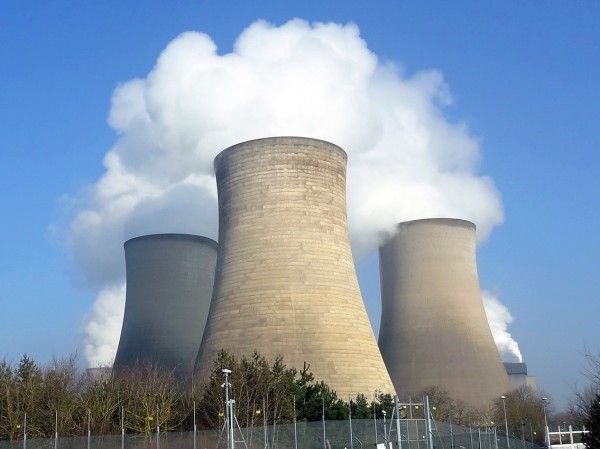 For all households, energy is considered an essential item. As electricity and gas prices rise and fall, many of us don’t think twice about turning on the lights, cooking a meal or turning on the heating. We may complain about the cost and want prices brought down, but we still pay the bills. But, is there anything that can be done about high energy prices? And if there is, should anything be done?
For all households, energy is considered an essential item. As electricity and gas prices rise and fall, many of us don’t think twice about turning on the lights, cooking a meal or turning on the heating. We may complain about the cost and want prices brought down, but we still pay the bills. But, is there anything that can be done about high energy prices? And if there is, should anything be done?
The worlds of politics and economics are closely linked and Ed Miliband’s announcement of his party’s plans to impose a 20-month freeze on energy prices if elected in 2015 showed this relationship to be as strong as ever. The price freeze would certainly help average households reduce their cost of living by around £120 and estimates suggest businesses would save £1800 over this 20 month period. The energy companies have come in for a lot of criticism, in particular relating to their control of the industry. The sector is dominated by six big companies – your typical oligopoly, and this makes it very difficult for new firms to enter. Thus competition is restricted. But is a price freeze a good policy?
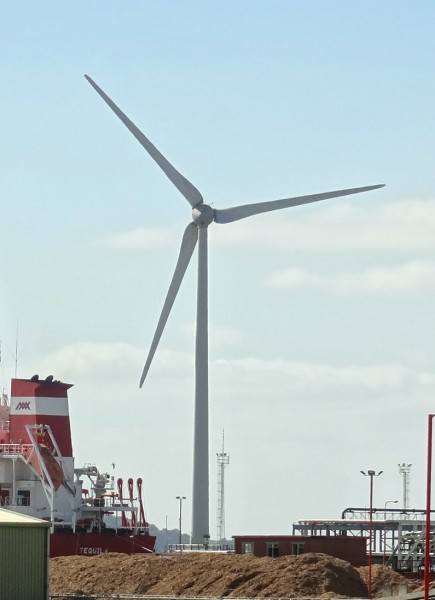 Part of the prices we pay go towards investment in cleaner and more environmentally friendly sources of energy. Critics suggest that any price freeze would deprive the energy sector of much needed investment, meaning our energy bills will be higher in the future. Furthermore, some argue this price freeze suggests that Labour is abandoning its environmental policy. Energy shortages have been a concern, especially with the cold weather the UK experienced a few years ago. This issue may reappear with price freezes. As Angela Knight, from Energy UK, suggests:
Part of the prices we pay go towards investment in cleaner and more environmentally friendly sources of energy. Critics suggest that any price freeze would deprive the energy sector of much needed investment, meaning our energy bills will be higher in the future. Furthermore, some argue this price freeze suggests that Labour is abandoning its environmental policy. Energy shortages have been a concern, especially with the cold weather the UK experienced a few years ago. This issue may reappear with price freezes. As Angela Knight, from Energy UK, suggests:
Freezing the bill may be superficially attractive, but it will also freeze the money to build and renew power stations, freeze the jobs and livelihoods of the 600,000-plus people dependent on the energy industry and make the prospect of energy shortages a reality, pushing up the prices for everyone.
There is a further concern and that is that large energy companies will be driven from the UK. This thought was echoed by many companies, in particular the British Gas owner Centrica, commenting that:
If prices were to be controlled against a background of rising costs it would simply not be economically viable for Centrica to continue to operate and far less to meet the sizeable investment challenge that the industry is facing…The impact of such a policy would be damaging for the country’s long-term prosperity and for our customers.
Share prices naturally fluctuate with global events and a political announcement such as this was inevitably going to cause an effect. But, perhaps the effect was not expected to be as big as the one we saw. 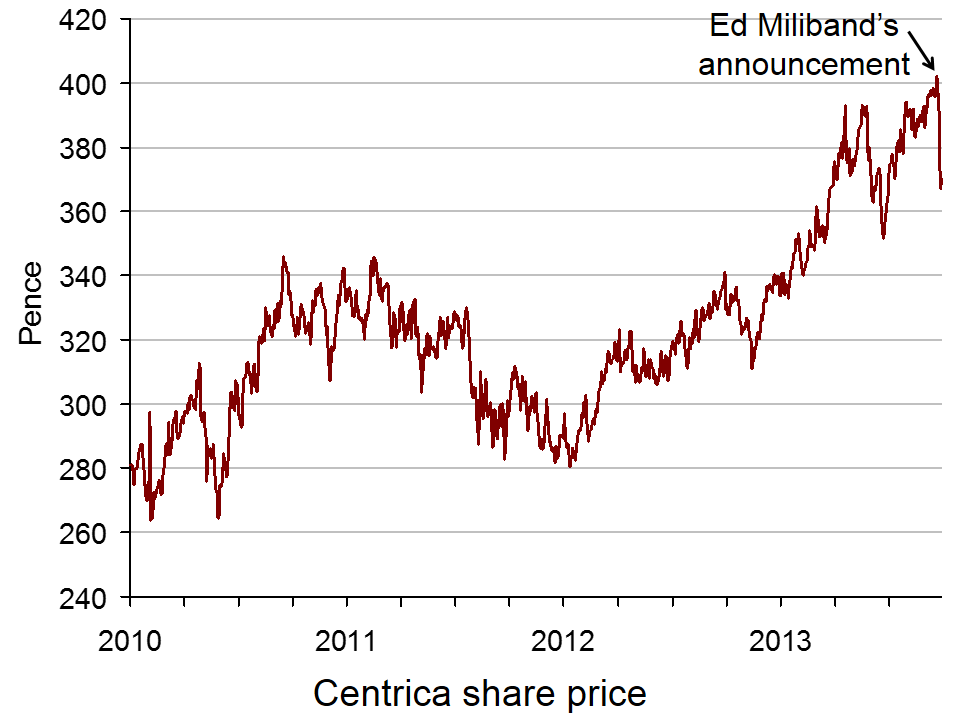 Share prices for Centrica and SSE fell following the announcement – perhaps no great shock – but then they continued to fall. The market value tumbled by 5% and share prices kept falling. This has led to Ed Miliband being accused of ‘economic vandalism’ by a major shareholder of Centrica, which is hardly surprising, given the estimated cost of such a price freeze would be £4.5 billion.
Share prices for Centrica and SSE fell following the announcement – perhaps no great shock – but then they continued to fall. The market value tumbled by 5% and share prices kept falling. This has led to Ed Miliband being accused of ‘economic vandalism’ by a major shareholder of Centrica, which is hardly surprising, given the estimated cost of such a price freeze would be £4.5 billion.
The economic implications of such a move are significant. The announcement itself has caused massive changes in the FTSE and if such a move were to go ahead if Labour were elected in 2015, there would be serious consequences. While families would benefit, at least in the short term, there would inevitably be serious implications for businesses, the environmental policy of the government, especially relating to investment and the overall state of the economy. The following articles consider the aftermath of Ed Miliband’s announcement.
Miliband stands firm in battle over fuel bills plan The Guardian, Patrick Wintour and Terry Macalister (25/9/13)
Michael Fallon calls Miliband’s energy prices pledge ‘dangerous’ Financial Times, Elizabeth Rigby and Jim Pickard (26/9/13)
Britain’s labour treads narrow path between populism and prudence Reuters (26/9/12)
Ed Miliband’s radical reforms will make the energy market work for the many Independent (26/9/13)
Has Labour fallen out of love with Business? BBC News (26/9/13)
Top Centrica shareholder Neil Woodford accuses Labour leader Ed Miliband of economic vandalism The Telegraph, Kamal Ahmed (25/9/13)
Centrica and SSE slide after Labour price freeze pledge The Guardian (26/9/13)
Ed Miliband’s energy price freeze pledge is a timely but risky move The Guardian, Rowena Mason (24/9/13)
Questions
- Why are energy prices such a controversial topic?
- How are energy prices currently determined? Use a diagram to illustrate your answer. By adapting this diagram, illustrate the effect of a price control being imposed. How could it create an energy shortage? What impact would this have after the 20-month price freeze
- Why would there be adverse effects on energy companies if prices were frozen and costs increased? Use a diagram to illustrate the problem and use your answer to explain why energy companies might leave the UK.
- How would frozen energy prices help households and businesses?
- Why were share prices in Centrica and SSE adversely affected?
- Is there an argument for regulating other markets with price controls?
- Why is there such little competition in the energy sector?
 Valued by private investors at more than $10 billion, the future listing on the stock market of Twitter, is an eagerly anticipated event. The necessary forms have been submitted to the US Securities and Exchange Commission (SEC) ahead of the initial public offering (IPO). Twitter will be looking to avoid the mistakes made by Facebook when they were first listed in May last year. Twitter has also announced its intentions to purchase MoPub, which is a firm specialising in mobile advert exchanges.
Valued by private investors at more than $10 billion, the future listing on the stock market of Twitter, is an eagerly anticipated event. The necessary forms have been submitted to the US Securities and Exchange Commission (SEC) ahead of the initial public offering (IPO). Twitter will be looking to avoid the mistakes made by Facebook when they were first listed in May last year. Twitter has also announced its intentions to purchase MoPub, which is a firm specialising in mobile advert exchanges.
So, what will this listing mean for Twitter? The public will now be able to purchase shares in Twitter, in much the same way as you can buy shares in RBS or Facebook. The financial performance of Twitter will come under much greater scrutiny from its shareholders, who will be interested in short term returns and long term stability. Becoming a public limited company will attract investors and is likely to provide a much larger scope for expansion for Twitter. However, as yet no details have been released on a likely date for the flotation or on the prices we can expect.
One thing Twitter will be trying to avoid is a repeat of the problems that beset Facebook and indeed of the problems that other public listings have created for giants such as Google, Zynga and Groupon. When Facebook moved to public ownership, its share prices initially fell below its IPO and subsequently Facebook lost more than half its value. More recent success in mobile advertising has restored the fortunes of this company, but Goldman Sachs, which is handling Twitter’s transition will be looking to avoid a similar occurrence. As Sam Hamadeh from PrivCo (a firm that gathers data on private companies) said:
Twitter will learn from Facebook’s flawed playbook and do the opposite … Unlike Facebook, which waited too long to IPO (until its growth rate decelerated), Twitter will IPO at just the right inflection point: while revenue grows in triple digits.
Twitter is a rapidly growing business, but still has significant scope for expansion and this move to public ownership may be just the thing. Setting the right IPO and the right date will be crucial, as a multitude of factors can and do affect the price of shares listed on the stock market. Twitter will also need to ‘focus on doing the right stuff’ to make a success of the listing and its purchase of Mopub looks to be a step in the right direction. For now, all we can do is speculate, but if the launch is successful, then the founders of Twitter are likely to bring in hundreds of millions of dollars each.
Twitte files for IPO The Telegraph, Sophie Curtis (13/9/13)
 Twitter plans stock market listing (see also) BBC News (13/9/13)
Twitter plans stock market listing (see also) BBC News (13/9/13)
Twitter files for IPO, hopes to avoid Facebook’s mistakes Independent, Nikhil Humar and James Vincent (12/9/13)
Facebook shares close 11% below flotation price BBC News (21/5/12)
Twitter fails to answer key IPO questions Financial Times, Richard Waters and April Dembosky (13/9/13)
Twitter IPO: how much is it worth? The Guardian, Juliette Garside (13/9/13)
Twitter IPO: Tech float successes and disasters The Telegraph, Gabrielle Putter and Szu Ping Chan (13/9/13
 Twitter to see ‘strong demand’ for share sale BBC News (13/9/13)
Twitter to see ‘strong demand’ for share sale BBC News (13/9/13)
Twitter IPO: Firm in stock market launch bid Sky News (13/9/13)
Questions
- What are the characteristics of a public limited company? Are there advantages and disadvantages?
- Which factors affect (a) the supply of shares and (b) the demand for shares?
- What mistakes were made by Facebook when it made the transition to public ownership?
- How does advertising generate revenue for Twitter?
- How might you go about valuing Twitter or Facebook?
- Companies such as Twitter and Facebook have hundreds of millions of subscribers. Are there network externalities of this?
- Twitter is purchasing MoPub. What type of takeover would you classify this as?
 The strength of the housing market is often a key indicator of the strength of the economy. But, the opposite is also true: a weak economy often filters through to create a weak housing market. With the current weak economy, a boost in confidence is needed and signs suggest that the housing market is beginning to recover.
The strength of the housing market is often a key indicator of the strength of the economy. But, the opposite is also true: a weak economy often filters through to create a weak housing market. With the current weak economy, a boost in confidence is needed and signs suggest that the housing market is beginning to recover.
While the picture of the housing market today is nothing like the pre-crisis view, things are beginning to look up. For a couple of years now, house price inflation in the UK has been very close, if not equal to zero. However, data from Nationwide Building Society suggests that in May, house prices rose by 0.4% and the once stagnant year-on-year change in house prices rose to 1.1% (see chart below: click here for a PowerPoint of the chart). This is the fastest it has grown since the end of 2011.
Commentators have suggested that this latest data is an indication that ‘the market is gaining momentum’. A further confirmation of this rejuvenated market came with the data that property sales were 5% up each month this year, than the average monthly level for 2012. Despite this improvement, they still remain well below the pre-crisis levels.
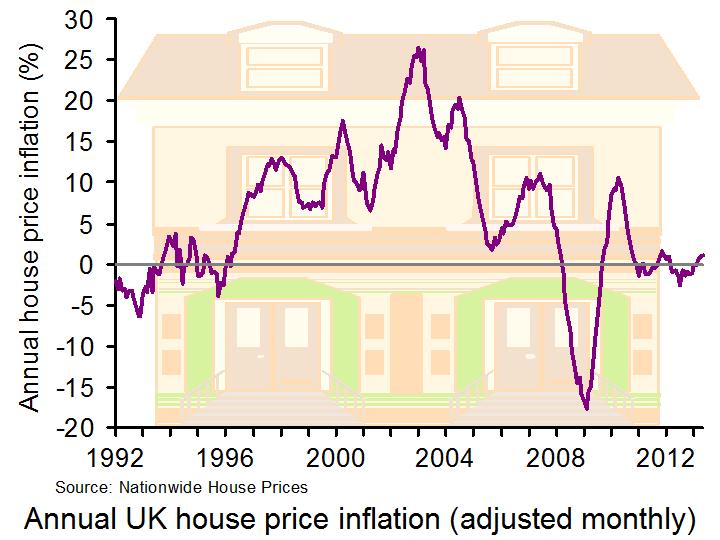 Which factors have contributed to this tentative recovery? Most households require a mortgage to purchase a house and, given the central role that the housing market played in the financial crisis with companies engaging in excessive lending as a means of expanding their mortgage books, the availability of mortgages fell. The number of mortgage approvals is likely to feed through to affect the number of house sales and these have improved in the first few months of 2013. Interest rates offered by lenders have also fallen, making mortgages more affordable, thus boosting demand. Furthermore, government assistance is available to help individuals put a deposit down on a house, by offering them an equity loan. Further measures are due to come into effect in January 2014, with the aim of providing a further boost to the housing market. The chief economist at Nationwide, Robert Gardner said:
Which factors have contributed to this tentative recovery? Most households require a mortgage to purchase a house and, given the central role that the housing market played in the financial crisis with companies engaging in excessive lending as a means of expanding their mortgage books, the availability of mortgages fell. The number of mortgage approvals is likely to feed through to affect the number of house sales and these have improved in the first few months of 2013. Interest rates offered by lenders have also fallen, making mortgages more affordable, thus boosting demand. Furthermore, government assistance is available to help individuals put a deposit down on a house, by offering them an equity loan. Further measures are due to come into effect in January 2014, with the aim of providing a further boost to the housing market. The chief economist at Nationwide, Robert Gardner said:
Widespread expectations that the economy will continue to recover gradually in the quarters ahead, that interest rates will remain low, and the ongoing impact of policy measures aimed at supporting the availability and lowering the cost of credit all provide reasons for optimism that activity will continue to gain momentum in the quarters ahead.
Despite the optimism, the situation is different across the UK, with some areas benefiting more than others. London and the South-East are driving this 0.4% rise, whereas other areas may be in need of further assistance to keep pace (see The UK housing market: good in parts).
Although these latest data may be a sign of things to come, it is also possible that things could go the opposite way. Incomes remain low; employment data are hardly encouraging; and the spectre of inflation is always there. Perhaps most importantly, consumer confidence remains fragile and until that gains momentum, uncertainty will continue to plague the UK marketplace. The following articles consider this issue.
Articles
UK house prices again up in May, says Nationwide The Guardian, Hilary Osborne (30/5/13)
Housing market could boost retail industry, Kingfisher says The Telegraph, Graham Ruddick (30/5/13)
UK house prices see modest rise, says Nationwide BBC News (30/5/13)
 Hugh’s Review: House prices in spotlight BBC News, Hugh Pym with Yolande Barnes of Savills and Matthew Pointon of Capital Economics (31/5/13)
Hugh’s Review: House prices in spotlight BBC News, Hugh Pym with Yolande Barnes of Savills and Matthew Pointon of Capital Economics (31/5/13)
House prices are racing ahead as stimulus for the market kicks in Independent, Russell Lynch (31/5/13)
’Pick up’ in house prices recorded in sign of market confidence, says Nationwide Independent, Vicky Shaw (30/5/13)
House prices at highest level for nearly two years as confidence in UK economy grows and mortgages get cheaper This is Money, Matt West (30/5/13)
Stamp duty is ‘choking’ housing market as it rises seven times faster than inflation over last 15 years Mail Online, Tara Brady (28/5/13)
Nationwide launches Help to Buy mortgages The Telegraph, William Clarke (29/5/13)
UK home prices rise most in 18 months, Nationwide says Bloomberg, Jennifer Ryan (30/5/13)
House price data
Links to house price data The Economics Network
Statistical data set – Property transactions Department of Communities and Local Government
Nationwide house price index Nationwide Building Society
Halifax House Price Index Lloyds Banking Group
Lending to individuals – November 2012 Bank of England
Questions
- How is the equilibrium determined in the housing market? Using a demand and supply diagram, illustrate the equilibrium. Make sure you think about the shapes of the curves you’re drawing.
- Which factors affect the demand for and supply of housing?
- Why are there regional variations in house prices?
- Why is the housing market a good indicator of the strength of the economy?
- Why have house prices risen throughout 2013? Is the trend likely to continue?
- If the housing market does indeed gain momentum, how might this affect the rest of the economy? Which sectors in particular are likely to benefit?
- Explain why the government’s intervention in the housing market could be seen to have a multiplier effect?
- Concerns have been raised that the government’s schemes to help the housing market may create a house price bubble. Why might this be the case?
 A simple model in economics is that of demand and supply. Through the price mechanism, signals are sent between consumers and producers and this interaction results in an equilibrium market price and quantity. However, what happens when the market for a good or service is in disequilibrium?
A simple model in economics is that of demand and supply. Through the price mechanism, signals are sent between consumers and producers and this interaction results in an equilibrium market price and quantity. However, what happens when the market for a good or service is in disequilibrium?
When a market is in equilibrium, demand equals supply. However, as we discussed in a previous blog concerning baby milk in China (see Milking the economy), markets are not always in equilibrium. If demand exceeds supply, a shortage will emerge and to eliminate this, the price must rise. If, on the other hand, supply exceeds demand, there will be an excess supply and thus the price must fall to restore equilibrium.
The market in question here is toilet paper in Venezuela! A severe shortage of this product has emerged in recent months, with shops running out of supplies. In a bid to relieve this shortage, the country’s Minister of Commerce has received approval for a $79 million credit, which can be used to import this basic product in short supply. Fifty million rolls will be imported to help fill the shortage that has emerged. The shortage is not just a problem for toilet paper, but also across a range of basic consumer goods. The article from Reuters comments that:
The government says the toilet paper shortages, like others, are the results of panicked buying and unscrupulous merchants hoarding the goods to artificially inflate prices.
Opposition critics say the problem is caused by the currency controls, created a decade ago by late socialist leader Hugo Chavez, and years of nationalizations that weakened private industry and left businesses unwilling to invest.
With shortages across a variety of products, the President has begun to work closely with business leaders to address this situation. The following articles consider this basic market, the intervention and consequences.
Venezuela hopes to wipe out toilet paper shortage by importing 50m rolls The Guardian (16/5/13)
Venezuela ends toilet paper shortage BBC News (22/5/13)
With even toilet paper scarce, Venezuelan president warms to business Reuters, Eyanir Chinea (22/5/13)
Toilet paper shortage in Venezuela to end after lawmakers back plans to import 39 million rolls Huffington Post, Sara Nelson (22/5/13)
Venezuela’s toilet paper shortage ended; 3 other basic goods that went scarce in the country International Business Times, Patricia Rey Mallen (22/5/13)
Questions
- Using a demand and supply diagram, explain how equilibrium is determined in a free market.
- Illustrate the shortage described in the aticles on your above demand and supply diagram. How should the price mechanism adjust?
- What types of government intervention have led to the shortages of such basic consumer goods?
- How have currency controls created a problem for Venezuela?
- With an increase in imported products, what impact might there be on Venezuela’s exchange rate and on its balance of payments?
 The cost of living is a contentious issue and is likely to form a key part of the political debate for the next few years. This debate has been fuelled by the latest announcement by SSE of an average rise in consumer energy bills of 8.2%, meaning that an average dual-fuel customer would see its bill rise by £106. With this increase, the expectation is that the other big energy companies will follow suit with their own price rises.
The cost of living is a contentious issue and is likely to form a key part of the political debate for the next few years. This debate has been fuelled by the latest announcement by SSE of an average rise in consumer energy bills of 8.2%, meaning that an average dual-fuel customer would see its bill rise by £106. With this increase, the expectation is that the other big energy companies will follow suit with their own price rises. Customers with other energy companies are likely to see similar price rises in the coming months, as SSE’s announcement is only the first of many. A key question is how will the country provide the funding for much needed investment in the energy sector? The funds of the government are certainly not going to be available to provide investment, so the job must pass to the energy companies and in turn the consumers. It is this that is given as a key reason for the price rises.
Customers with other energy companies are likely to see similar price rises in the coming months, as SSE’s announcement is only the first of many. A key question is how will the country provide the funding for much needed investment in the energy sector? The funds of the government are certainly not going to be available to provide investment, so the job must pass to the energy companies and in turn the consumers. It is this that is given as a key reason for the price rises. More energy price rises expected after SSE increase BBC News (10/10/13)
More energy price rises expected after SSE increase BBC News (10/10/13)





